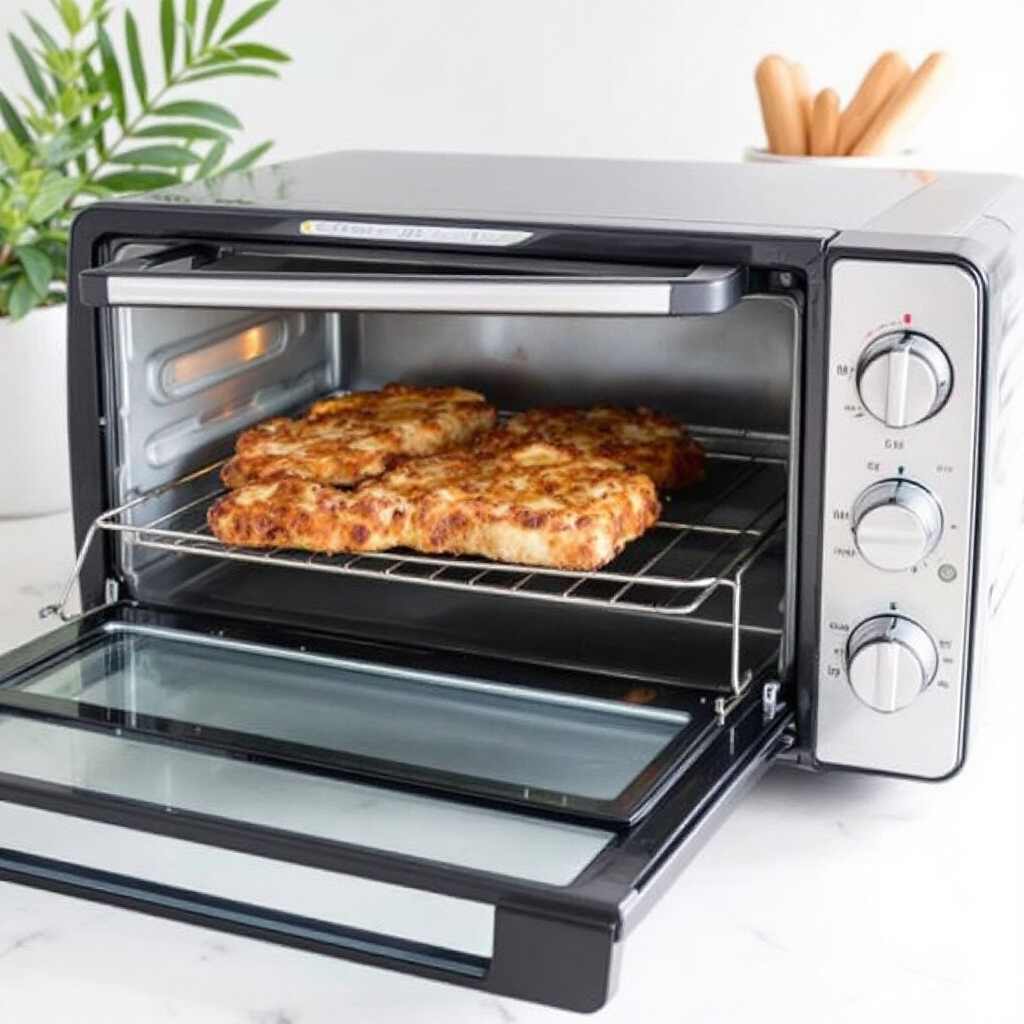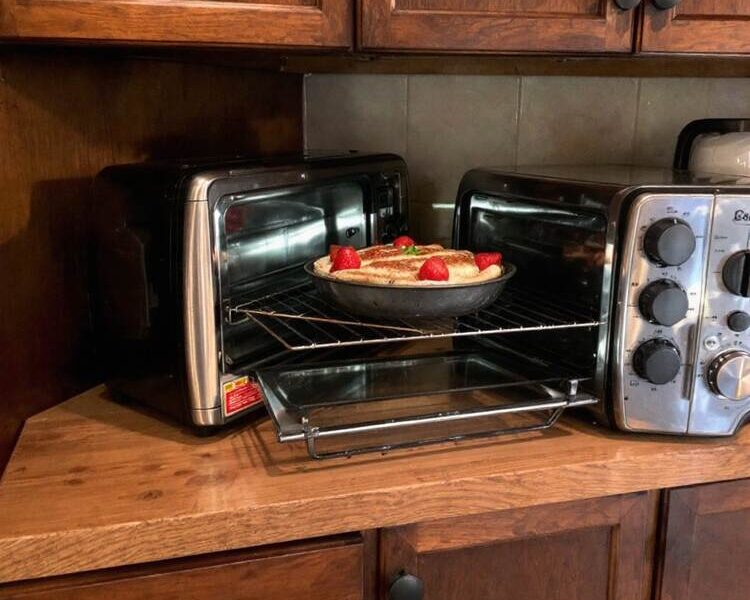Toaster ovens have become a staple in modern kitchens, and for good reason. These versatile appliances toast bread and bake, broil, and reheat various foods. Their compact size makes them ideal for small kitchens, while their multifunctionality appeals to those who love to cook. Whether you’re a busy professional, a student, or a parent juggling multiple tasks, a toaster oven can significantly enhance your cooking efficiency.
Choosing the right toaster oven is crucial. With so many options available, finding one that meets your specific needs can be overwhelming. The right appliance can save you time and energy and even improve the quality of your meals. Imagine whipping up a quick dinner or snack without the hassle of preheating a full-sized oven.
Understanding Toaster Ovens

What is a Toaster Oven?
A toaster oven is a compact kitchen appliance that combines the functions of a toaster and a conventional oven. It typically features a heating element at the top and bottom, allowing it to toast, bake, and broil food. Unlike traditional ovens, toaster ovens heat up quickly and are more energy-efficient, making them perfect for small meals or snacks.
Comparison with Traditional Ovens and Toasters:
- Size: Toaster ovens are smaller and can fit on countertops, while traditional ovens require more space.
- Functionality: While toasters are limited to browning bread, toaster ovens can handle various cooking tasks, including baking and broiling.
- Energy Use: Toaster ovens consume less energy than full-sized ovens, making them a more eco-friendly option for quick cooking.
Benefits of Using a Toaster Oven
Toaster ovens offer several advantages that make them a popular choice among home cooks:
- Energy Efficiency: They use less energy than traditional ovens, which benefits both the environment and your utility bills.
- Versatility in Cooking: You can bake cookies, broil chicken, or toast bagels all in one appliance. This versatility allows you to experiment with different cooking methods without needing multiple devices.
How Toaster Ovens Work
Toaster ovens operate using heating elements that generate heat. Most models have both top and bottom heating elements, which can be controlled independently. This allows for precise cooking, as you can adjust the temperature and cooking time based on your preparation.
Temperature Control: Many toaster ovens come with adjustable temperature settings, enabling you to perfectly cook various dishes. Some advanced models even feature digital controls for more precise cooking.
Key Features to Consider When Shopping for Toaster Ovens
When shopping for a toaster oven, consider several key features to ensure you choose the right one for your kitchen.
Size and Capacity
Toaster ovens come in various sizes, from compact models suitable for small kitchens to larger ones that accommodate multiple dishes. When selecting a size, consider your kitchen space and cooking needs.
- Small Models: Ideal for individuals or couples, these can toast a few slices of bread or bake small dishes.
- Medium to Large Models: Suitable for families, these can handle larger meals and multiple servings.
Heating Elements
Toaster ovens typically feature either conventional or convection heating.
- Conventional Heating: Uses heating elements to cook food. It’s effective but may result in uneven cooking.
- Convection Heating: Circulates hot air around the food, promoting even cooking and browning. This is particularly beneficial for baking.
Controls and Settings
The controls on a toaster oven can vary significantly:
- Manual Controls: Simple dials for temperature and timer settings. These are user-friendly but may need more precision.
- Digital Controls: Offer more features, such as preset cooking functions and timers. These can enhance your cooking experience by providing more control.
Additional Features
When shopping for toaster ovens, consider these additional features that can enhance functionality:
- Rotisserie Functions: Great for roasting meats evenly.
- Air Frying Capabilities: Allows you to enjoy crispy foods with less oil.
- Self-Cleaning Options: Makes maintenance easier by reducing the need for manual cleaning.
Top Brands in the Market
Regarding toaster ovens, several brands stand out for their quality and performance. Here’s a brief overview of some of the leading brands:
Brand Overview
- Breville: Known for its high-end appliances, Breville toaster ovens often feature advanced technology and sleek designs.
- Cuisinart: Offers a range of toaster ovens that are user-friendly and versatile, making them a favorite among home cooks.
- Hamilton Beach: Provides budget-friendly options without compromising quality, making them accessible for everyone.
Brand Comparisons
Here’s a comparison table of some top brands, highlighting their key features, price range, and customer ratings:
BrandKey FeaturesPrice RangeCustomer Rating
Breville Convection, smart settings $$ ★★★★☆
Cuisinart Multiple functions, easy clean $ ★★★★
Hamilton Beach Budget-friendly, reliable $ ★★★★☆
Best Models to Shop For
With so many options available, knowing which models stand out for different needs is essential. Here are our top picks:
Top Picks for Different Needs
- Best for Small Kitchens: Look for compact models that fit easily on countertops without sacrificing functionality.
- Best for Families: Choose larger models with higher capacity to accommodate multiple servings.
- Best Budget Option: Consider brands like Hamilton Beach that offer reliable performance at a lower price point.
Model Reviews
Let’s take a closer look at some selected models:
- Breville BOV900BSS: This model features smart settings and convection cooking, making it perfect for baking and roasting. Users praise its sleek design and even cooking.
- Cuisinart TOB-260N1: Known for its versatility, this toaster oven can handle everything from toasting to baking. It has a spacious interior and easy-to-use controls.
- Hamilton Beach 31103DA: A budget-friendly option that doesn’t skimp on quality. It’s perfect for basic cooking needs and has received positive feedback for its reliability.
How to Maintain Your Toaster Oven
Regular maintenance is critical to ensure your toaster oven lasts for a year.
Cleaning Tips
- Wipe Down After Each Use: Clean the interior and exterior with a damp cloth to prevent buildup.
- Remove Crumbs Regularly: Empty the crumb tray frequently to avoid fires and maintain hygiene.
Troubleshooting Common Issues
Even the best appliances can encounter problems. Here are some common issues and simple fixes:
- Uneven Cooking: Ensure the heating elements function correctly and that food is placed evenly.
- Burning Smell: This may occur if food particles are stuck in the oven. Regular cleaning can help prevent this.
Frequently Asked Questions
As you consider purchasing a toaster oven, you might have some questions. Here are answers to common queries:
What can you cook in a toaster oven?
You can cook various foods, including toast, pizza, cookies, and roast meats. The versatility of toaster ovens makes them suitable for many cooking tasks.
Are toaster ovens worth it?
Absolutely! They save energy, time, and space while offering multiple cooking functions. For many households, they are a valuable addition to the kitchen.
How do I choose the right size?
Consider your kitchen space and how many people you typically cook for. A larger model may be necessary if you often prepare meals for a family, but a compact model will suffice for individuals or couples.
Conclusion
In conclusion, selecting the right toaster oven can significantly enhance your cooking experience. With the right appliance, you can enjoy the convenience of quick meals without sacrificing quality.




